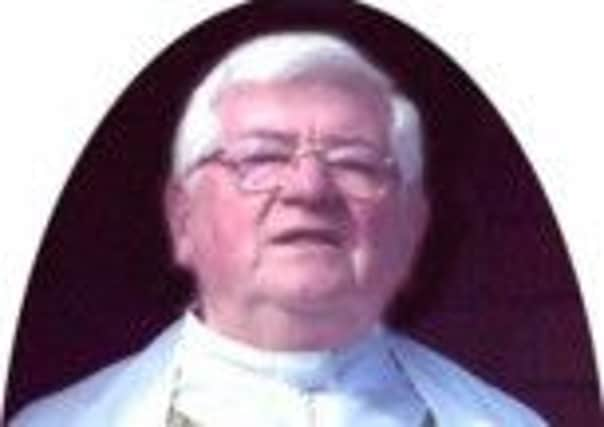Obituary: Canon Michael J Cassidy, priest


Canon Michael J Cassidy was born in the west of Ireland at Brackloon outside Swinford in County Mayo, the son of headmaster John F Cassidy and his wife, teacher Mary Kate Rooney, in a family of 11 children.
After his initial schooling locally, he moved to study for the priesthood at St Peter’s College, Wexford. There, in 1954, he was ordained for the archdiocese of St Andrews and Edinburgh by Bishop James Staunton of Ferns in the elegant College chapel designed by Augustus Welby Pugin.
Advertisement
Hide AdAdvertisement
Hide AdHis first parish was St Francis Xavier’s in industrial Falkirk (1954-55) and then at St John Vianney’s in Gilmerton, Edinburgh.
Six years followed in rural East Lothian at the mining heartland of Tranent (1960-64) and then in the balmy seaside resort of North Berwick (1964-66). His first appointment as parish priest was then at St Mary’s, Pathhead to allow him to focus on his ministry to migrant workers. In 1976 he was appointed parish priest at St Margaret Mary’s, Granton in Edinburgh. He retired in 2005.
Much of his life was spent caring for and protecting exploited and marginalised migrant and immigrant workers and boat people from South-east Asia, “down and outs” and travelling people.
The then Father Cassidy was given a roving commission to care for the Irish migrant agricultural workers.
This was not a new phenomenon. In 1920 Bishop Grey Graham told his priests that a committee in Ireland was investigating the plight of potato workers, especially women and girls. In the spring of 1971 attention was focussed on the activities of 18 contractors or “gaffers” in East Lothian who employed around 600 men and women in the potato fields.
Along with Fr Michael Walsh of Dunbar, Fr Cassidy became active in highlighting the plight of the potato workers, many of them, alleged Fr Cassidy, the victims of “old slave-type tactics” and intimidation, allegations that he gave substance to in a report submitted to Cardinal Gordon Gray of St Andrews and Edinburgh.
As a result of this report, Gordon Campbell, Secretary of State, directed the Department of Agriculture’s Wages and Safety Inspectorate (in collaboration with the Department of Health and Social Security) to investigate the matter.
East Lothian MP, John P Mackintosh, Alex Eadie MP and Tom Oswald MP also took a keen interest in the potato workers and what the press referred to as “slave camps”.
Advertisement
Hide AdAdvertisement
Hide AdThe Irish parliamentarian, Tom Harte TD, spent three days looking into their living conditions. In July 1971 a News of the World journalist, Gerry Brown, posed as a potato worker and reported that: “My finger nails were cracked and bleeding, my hands ripped by stone fragments.”
In his report to Cardinal Gray, Fr Cassidy pointed to the employment of 14-year-olds recruited in Ireland.
By now, the Irish authorities were poised to take action. Stephen Coughlan TD informing the Secretary of State for Scotland that bothies at Humbie Mill in East Lothian and Dunglass Mill in Berwickshire were overcrowded and separate quarters for men and women not provided. The Dalkeith Presbytery of the Church of Scotland expressed grave concern at the ill-treatment of the workers.
Meanwhile, Fr Walsh had established an escape route back to Ireland and together, both priests managed to repatriate 30 men with the help of money sent by a social service centre in the Irish Republic.
In his report Fr Cassidy commented that: “There are contractors who seem interested only in getting rich quick and the freedom and dignity of their workers means nothing to them. When they complain about the conditions the strong-arm men take over and men and women are assaulted and beaten to make them stay. They are too scared to go to the police – or even complain to the farmers on whose land they work.”
Although the police and the local authority were also involved, no prosecutions were brought. The relentless publicity (including fictionalisation in the BBC Two detective drama Philomena and The Tattie-Howkers, an episode of A View from Daniel Pike starring Roddy McMillan) eventually forced the gangers to upgrade their facilities and pay better wages. As for Fr Cassidy, who had even received death threats, he was later honoured by the Irish government for his services to his fellow-countrymen.
When Canon Cassidy celebrated the jubilee of his priesthood he received a letter from the Irish Taoiseach, Bertie Ahern, thanking him for the tireless and unstinting work he had done for the Irish migrant community in Scotland.
He loved reciting poetry and also had a keen sense of humour. In 1991 Fr Cassidy received a mysterious phone call late one night at his Granton presbytery. The anonymous caller told him to go out and open a parcel lying at his front door.
Advertisement
Hide AdAdvertisement
Hide AdHe found a large packet and when he opened it, it turned out to be a painting on canvas by the Scottish artist, William Dyce (1806-64) entitled John Knox Administering the Sacrament at Calder House, 1556, which had been stolen some weeks before from the John Knox Museum in Edinburgh’s High Street.
Fr Cassidy handed the painting, which was worth £50,000, to the police and it was duly returned to its owner. He commented later that: “It was grand that we could make such a fine ecumenical gesture after 400 years in returning John Knox to his gallery.”